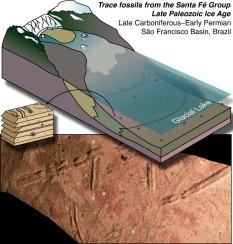Expanding the ichnological record of the Late Paleozoic Ice Age: Evidence from the Santa Fé Group, São Francisco Basin (Brazil)
IF 2.7
2区 地球科学
Q2 GEOGRAPHY, PHYSICAL
Palaeogeography, Palaeoclimatology, Palaeoecology
Pub Date : 2025-10-12
DOI:10.1016/j.palaeo.2025.113337
引用次数: 0
Abstract
The Late Paleozoic Ice Age (LPIA) left a significant sedimentary record across Pangea. In Brazil, although the Paraná Basin has provided extensive records of glacial dynamics, the contemporaneous deposits of the Santa Fé Group in the São Francisco Basin (Minas Gerais state) remain comparatively underexplored. These strata preserve a variety of glacially influenced facies, including diamictites, rhythmites, glaciofluvial sandstones, and outsized clasts, but their ichnological content has not been systematically assessed. Here it is presented a detailed analysis of trace fossil assemblages from these deposits, documenting low-diversity ichnoassemblages (Cruziana problematica, Cruziana diplopoda, Diplichnites gouldi, Diplopodichnus biformis, Rusophycus carbonarius, and Helminthoidichnites tenuis) preserved in association with glaciogenic facies. The ichnofossils assist in the recognition of glacial processes on benthic colonization, substrate conditions, and ecosystem recovery during deglaciation phases. By expanding ichnological data beyond the Paraná Basin, these results highlight the potential of the Santa Fé Group to refine paleoecological and paleogeographic reconstructions of Gondwanan icehouse systems, and to better characterize the environmental signatures of the LPIA in Brazil.

扩展晚古生代冰期的技术记录:来自巴西 o Francisco盆地Santa f群的证据
晚古生代冰期(LPIA)在整个泛大陆留下了重要的沉积记录。在巴西,尽管帕拉纳盆地提供了大量的冰川动力学记录,但在s o Francisco盆地(Minas Gerais州)的Santa f群的同时期沉积物仍然相对较少。这些地层保存了多种受冰川影响的相,包括二晶岩、节奏岩、冰川河流砂岩和超大碎屑,但它们的技术含量尚未得到系统评估。本文对这些沉积物中的微量化石组合进行了详细的分析,记录了与冰川期相有关的低多样性的化石组合(Cruziana problematica、Cruziana diploopodida、Diplichnites gouldi、Diplopodichnus biformis、Rusophycus carbonarius和Helminthoidichnites tenuis)。鱼化石有助于认识底栖生物定殖、底物条件和消冰期生态系统恢复的冰川过程。通过将技术数据扩展到帕拉纳盆地以外,这些结果突出了Santa f小组在完善Gondwanan冰窖系统的古生态和古地理重建以及更好地表征巴西LPIA的环境特征方面的潜力。
本文章由计算机程序翻译,如有差异,请以英文原文为准。
求助全文
约1分钟内获得全文
求助全文
来源期刊
CiteScore
5.90
自引率
10.00%
发文量
398
审稿时长
3.8 months
期刊介绍:
Palaeogeography, Palaeoclimatology, Palaeoecology is an international medium for the publication of high quality and multidisciplinary, original studies and comprehensive reviews in the field of palaeo-environmental geology. The journal aims at bringing together data with global implications from research in the many different disciplines involved in palaeo-environmental investigations.
By cutting across the boundaries of established sciences, it provides an interdisciplinary forum where issues of general interest can be discussed.

 求助内容:
求助内容: 应助结果提醒方式:
应助结果提醒方式:


